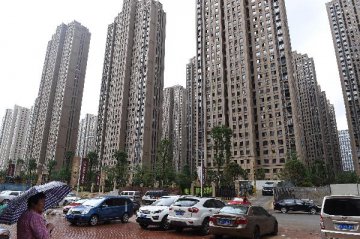
China’s local fixed assets investment accelerates as the year-end is around the corner.
According to the data released on Oct. 24, China has realized fixed assets investment of 42,690.6 billion yuan (excluding agricultural investment) in the first three quarters, up 8.2 percent year on year and 0.1 percentage points higher than the growth rate in the first eight months, ending the downtrend of investment at the beginning of the year. In particular, local investment increased by 8.5 percent year on year to hit 40,974.1 billion yuan, representing 0.5 percentage points higher than the first eight months and 0.3 percentage points higher than the national average in terms of the growth rate.
The upward momentum continued in October. On Oct. 11, the National Development and Reform Commission (NDRC) published approvals for two major railway projects which involve total investment of 79.5 billion yuan.
Meanwhile, Journalist of the 21st Century Business Herald learnt that local areas’ enthusiasm for fixed assets investment upsurges since entering the fourth quarter. For example, Zhejiang Province announced trillion-yuan scale comprehensive transportation projects; Henan Province accelerated constructions of major projects, and investment in 1,065 of such projects totaled nearly a trillion yuan, with half of which are infrastructure constructions.
“In the context of home purchase restriction and absence of new growth points for manufacturing investment, it is not realistic to invest in areas other than infrastructure in the fourth quarter or afterwards. There’s huge downward pressure in fixed assets investment,” Pan Gangyi, head of the general office of Zhejiang Development& Planning Institute, indicated in an interview with the 21st Century Business Herald on Oct. 25.
Local fixed assets investment heats up
Fixed assets investment was the highlight of the economic data in the third quarter. Data shows that growth rates of fixed assets investment and private fixed assets investment for the first nine months have increased to 8.2 percent and 2.5 percent respectively, continuing the upswing in August.
While local fixed assets investment was the strongest impetus.
Henan Provincial Department of Housing and Urban-Rural Development on Oct. 11 issued the Notice on Accelerating Constructions of Major Projects in the Province (hereinafter referred to as the “Notice”), requiring its prefectures to accelerate urban construction and perfect urban function and push for the construction of major project constructions, including new-type of urbanization construction projects, key provincial construction projects and projects charged by provincial government leaders.
Excluding 19 repeated projects, there are all together 1,065 new-type urbanization construction projects and provincial key construction projects in the disclosed list of projects, with total investment of 941.09 billion yuan.
Journalist of the 21st Century Business Herald found that infrastructure construction projects make up the largest component of all the key projects. In the 1,048 new-type urbanization construction projects, urban and rural infrastructure projects see total investment of 415,614 million yuan and 8,863 million yuan respectively, representing half of the total investment.
Zhejiang Province also announced recently that in the next few years, it will invest over 1 trillion yuan for comprehensive transportation infrastructure construction in the whole province, including investments in railway and urban rail transit, highway, station, water way, civil airport and pipeline of approximate 500 billion yuan, approximate 400 billion yuan, 46 billion yuan, 70 billion yuan, 25 billion yuan and 35 billion yuan respectively.
“During the 13th Five-year period, Zhejiang will regard transportation construction as the most important basic task. It is the foundation for Zhejiang to realize modernization, interconnection and develop metropolitan economic circle. At the present, the connection between different regions in Zhejiang is not close enough,” said Pan.
“But on the other hand, Zhejiang also faces huge downward pressure in investment. We need new investment in infrastructure,” Pan pointed out.
Take a look at the full picture of China, infrastructure investment in the first three quarters increased by 19.4 percent year on year. Despite the growth rate was 0.3 percentage points lower than the first eight month, it was still 11.2 percentage points higher than the total investment growth. Infrastructure investment accounted for 19.5 percent of the total investment, up 1.8 percentage points from the same period last year. It drove the total investment to increase by 3.4 percentage points, up 0.4 percentage points from the same period last year.
It reflects that infrastructure has played a vital role in fixed assets investment and stabilizing growth.
Investment in railroad, waterway, highway and aviation remained at high level
Infrastructure constructions concentrated in railroad, waterway, highway and aviation sectors.
During the 13th Five-year period, investment in railroad construction is expected to continue to maintain the high level of 800 billion yuan per year. Urban rail transit will embrace rapid development.
Take Zhejiang’s trillion-yuan transportation projects for example, the province aims to build 3,900 km railroad transport network, 300 km metropolitan inter-city railway, 380 km urban railway transit and complete key highway projects by 2020.
In addition, Zhejiang will build Hangzhou airport into the regional international gateway airport, promote Ningbo and Wenzhou airports to develop into large scale airport with passenger throughput of tens of millions, as well as improve the passenger throughput of regional airports such as Yiwu, Taizhou, Zhoushan and Quzhou airports, to form interconnected general airport networks and 1 hour air-traffic circle.
Moreover, in the next five years, Zhejiang will also carry forward the construction of civil airports: accelerate the reconstruction and expansion project of Hangzhou Xiaoshan International Airport, speed up the phase III expansion of Ningbo Lishe International Airport and reconstruction and expansion of Wenzhou Longwan International Airport, building the latter two main airports into large airports with passenger throughput of tens of millions.
Public-private partnership (PPP) is an important model in promoting the construction of such projects. Henan Province proposed in the Notice that all prefectures in the province should deepen the innovation of investment and financing mechanisms, strengthen cooperation with social capitals and attract more social capitals, especially private capitals to invest in infrastructure and public service projects in the forms of franchising, government's purchasing of service and PPP. Henan also encourages investment promotion and capital introduction activities, to attract more social capitals to participate in infrastructure construction.
According to data from the PPP center of the Ministry of Finance, only about 20 percent of the PPP projects launched by local governments have been truly implemented.
Pan also admitted that there are still lots of problems in the operation of PPP model. “The crux of the problem is that original investing and financing models of local governments should change. The profit margin of PPP projects is in general not high. Enterprises were not interested in PPP projects two years ago when there were quite a lot of investment opportunities. And since other investment channels were scarce in the recent two years, to investment in PPP is more stable and safe. In the future, the implementation of PPP projects is expected to increase as the practice of the government become increasingly standard. This model will definitely become a general trend in the future,” said Pan.
Translated by Adam Zhang






















Latest comments